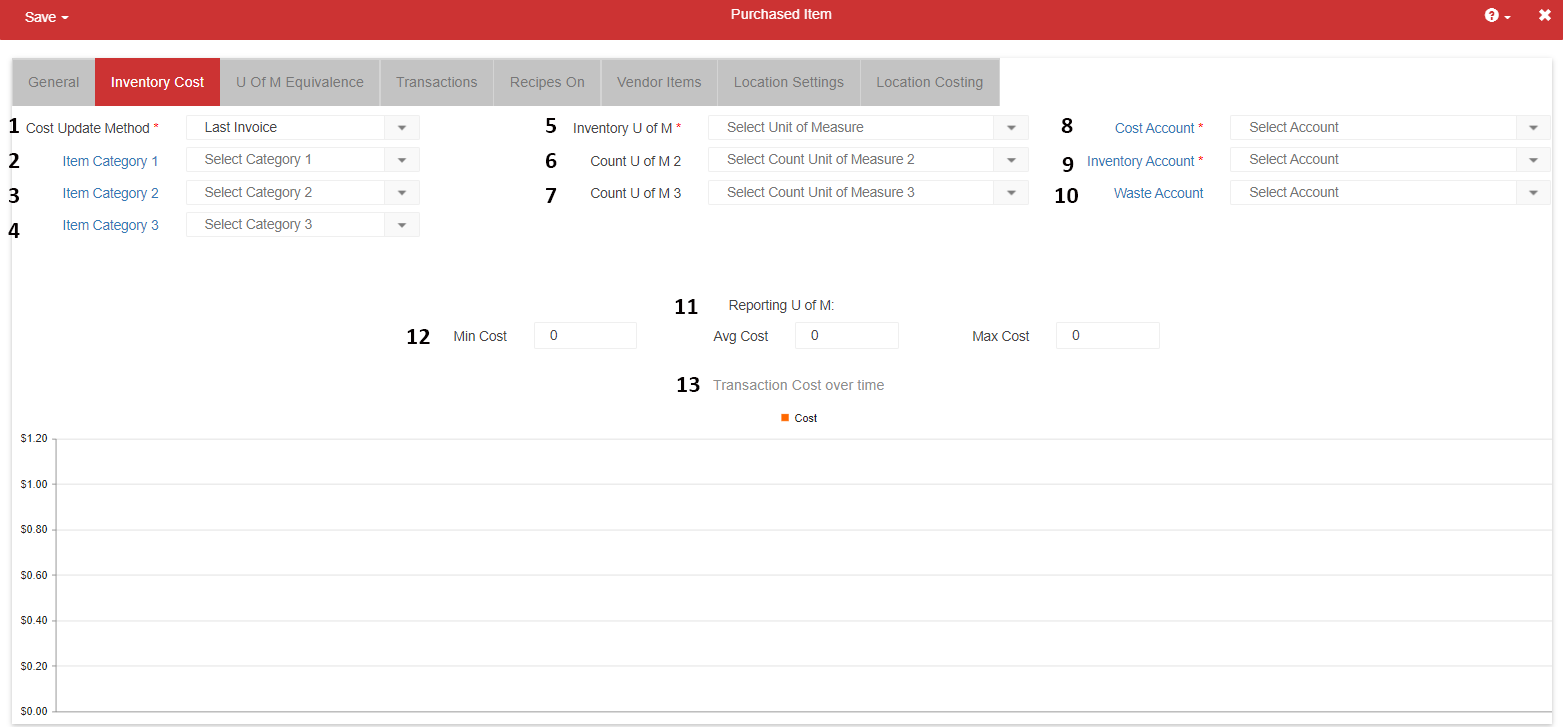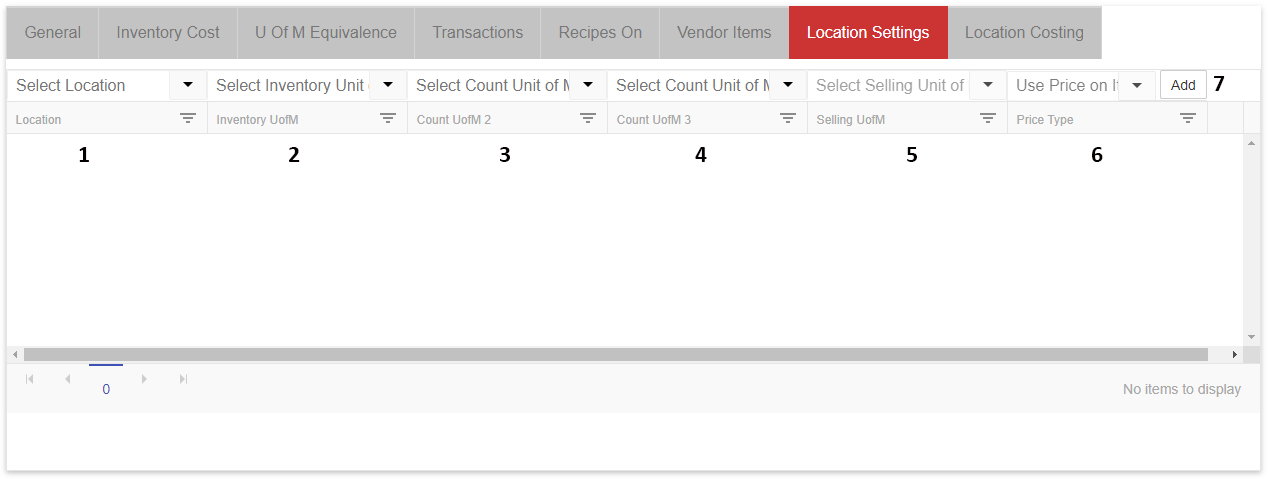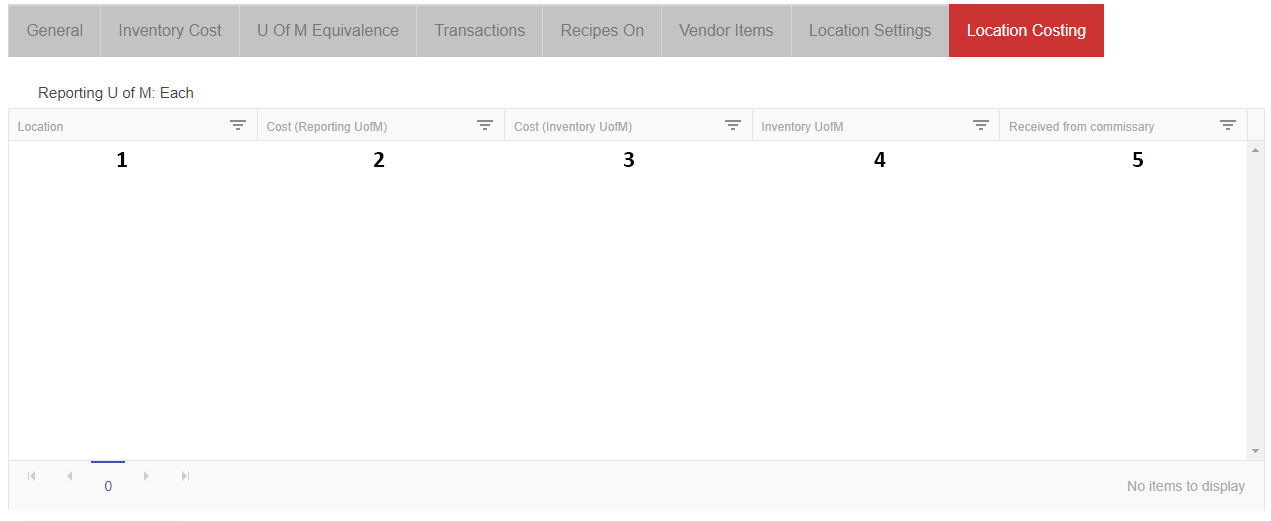
Purchased Items, along with Recipe Items and Sales Items, make up your Inventory in R365. Extra care should be paid when creating these various Inventory Items as they will have a lasting financial impact through the Inventory Count and Menu Item to Recipe Assignments. The R365 Ops Team is available to work with you as you setup your initial Inventory Database in R365.
We recommend that you create an individual Item Record for each Inventory Item you use in your Restaurants. Items may include Ingredients, Spices, Supplies, Paper, Packaging etc. Once an Item has been created, it can be counted on Inventory Counts, used as Ingredients in Recipes, and reported on in My Reports.
This article will detail each component of the Purchased Item Record. Click here to learn more about Item Costing in R365 and how you can get the most out of this powerful feature in the R365 Operations Module. If there is an outlier in your Item Location Pricing, click here to view how to update costs to reflect a more normal cost.
Want to learn Purchased Item best practices? View this training article.
Navigation
Open the Inventory app.
Expand Items.
Select Items (classic).

Purchased Item Record
General Tab

Name* - Enter the Name for the Purchased Item as it will appear throughout R365. Purchased Item Names must be unique
Type* - This value is read-only and cannot be modified. It identifies the Item as a Purchased Item
Measure Type* - This will identify the manner in which this item is measured throughout the system (Vendor Items, Item Locations, Recipe, and Inventory Transactions). Once set, Units of Measure can then be assigned. Ensure that the Measure Type is entered correctly because once the Item record is saved, the Measure Type will be locked and unchangeable. However, copying this item record will enable the Measure Type to be editable. These types include:
Weight
Volume
Each
To connect different Measure Types, you must set an equivalency since equivalencies will not be automatically created
Reporting U of M* - This is used on the Above Store AVT report to provide a consistent U of M for comparison.
Number (optional) - Enter a Number value for the Purchased Item. This value can be useful for filtering and sorting purposed in the 'Items' list. All alphanumeric characters are accepted in this field
Description - Enter a description for the Purchased Item. Similar to 'Number', this value is available on the 'Items' list
Active Checkbox - This box is checked by Default and indicates that this Purchased Item is Active in R365 and can be selected on AP Invoices, and counted on Stock Counts. When an Item is discontinued, uncheck this box to remove the Item from Item Selectors throughout R365
Actual as Theoretical Checkbox - Check this box to use the Actual Usage for this Item in place of the Theoretical Usage (via Recipes mapped to Menu Items) on the AvT Report
Commissary Item Checkbox - Check this box if this Purchased Item will also be available for ordering on a Commissary Order in the Commissary feature. When Checked, the 'Sales' tab will appear on the Purchased Item record. Click here for more information on how to setup Purchased Items as Commissary Items
Available in AR Invoice - Check this box if this Purchased Item will also be available as a Sales Item on the AR Invoice. When Checked, the 'Sales' tab will appear on the Purchased Item record. Click here for more information on how to setup Purchased Items as Sales Items
Catering Item Checkbox - Check this box if this Purchased Item will also be available for sale on Catering Menus in the Catering Module. When checked, the 'Catering' tab will appear on the Purchased Item record. Click here for more information on how to setup Purchased Items as Catering Items
Key Item - Check this box if this Purchased Item is considered a 'Key Item'. Key Items can be set on various Inventory reports to more quickly review the key / strategic inventory items
Select Recipe Image Button - This button is not applicable to Purchased Items and is only used on Recipe Items
Upload File Button - Attach a file to the Purchased Item record using this button
* Denotes a required field.
Inventory Cost Tab

Cost Update Method* - This method calculates the Inventory Cost value for each item. Click here to learn more about the Cost Update Methods, which include:
Weighted Average (Last Count) - R365 will use the Item Cost from the last approved Inventory Count and all subsequent approved costing transactions, which include Invoices, Item Transfers (Receiving Location only), and Commissary Fulfillments (Receiving Location only), for calculating an Item's weighted average. Click here to learn more about Weighted Average
Transaction line items with $0 or a negative quantity will be excluded
Weighted Average (Last 3) - R365 will use the Item Cost from the last three days of approved costing transactions, which include Invoices, Commissary Fulfillments (Receiving Location only), and Item Transfers (Receiving Location only). These costs will be taken from the unit cost of the transaction line items and calculated as a weighted average. Click here to learn more about Weighted Average
Transaction line items with $0 or a negative quantity will be excluded
Last Invoice - R365 will use the Item Cost from the last approved costing transaction, which includes Invoices, Commissary Fulfillments, and Item Transfers. If more than one transaction was approved on the same day, the Item Cost will be calculated as a weighted average. Click here to learn more about Weighted Average
Transaction line items with $0 or a negative quantity will be excluded
Manual - No Cost updates will be made by R365. The Inventory Cost value must be manually updated. This option is rarely used.
Item Category 1 - Enter an Item Category 1 for the Purchased Item. This should be the main category, such as 'Food'. Click here fore more information on Item Categories
Item Category 2 - Enter an Item Category 2 for the Purchased Item. This should be the secondary category within the main Category (Category 1), such as 'Meat'. Click here fore more information on Item Categories
Item Category 3 - Enter an Item Category 3 for the Purchased Item. These Categories are used infrequently but can represent the more detailed type within the Category 2, such as 'Beef'. Click here fore more information on Item Categories
Inventory U of M* - Select the primary U of M that is counted when the Purchased Item is counted on Inventory Counts. Click here for more information on U of Ms
'Inventory U of M' is referenced on most reports unless there is a Location-specific 'Inventory U of M' defined.
Count U of M 2 - Set a secondary Count U of M for the Purchased Item. Additional count units of measure allows you to count by multiple U of M during an Inventory Count
'Count U of M 2' is referenced on the 'Item Price Change Analysis' report
Count U of M 3 - Set a tertiary Count U of M for the Purchased Item. Additional count units of measure allows you to count by multiple U of M during an Inventory Count
Cost Account* - Select the GL Account where the Costs associated with this Purchased Item will be recorded (on AP Invoices, Stock Count Inventory Adjustments etc.)
Inventory Account* - Select the GL Account where the Inventory Asset Value associated with this Purchased Item will be recorded (on AP Invoices, Stock Count Inventory Adjustments etc.)
Waste Account - Select the GL Account that you want to Debit upon entering a Waste Log
Reporting U of M - the single Unit of Measure used across all locations, ensuring that the 'Average', 'Maximum' or 'Minimum' Item Costs are reported as compared to the same U of M. This can be changed on the 'General' tab
Costs - The minimum, average, and max Costs of the Item across all Locations based on the Reporting U of M
Transaction Cost Over Time Graph- As this Purchased Item is purchased over time, this graph will display each price at the time of purchase in a running line. This is based on the Reporting U of M. Points on the graph can be clicked to open AP Invoices
* Denotes a required field.
U of M Equivalence Tab

This tab is where a U of M can be related across Measure Types. It is important to note that this tab will prepopulate with the Inventory U of M or Purchase U ofM depending on which is selected first. If any information is cleared out of this tab, this will cause issues within the system. Click here for more information on U of M Equivalencies.
Transactions Tab

This tab will contain each of the Transactions (AP Invoice, AP Credit Memo, Stock Count etc.) where this Item has appeared in the past year. To view transactions beyond the past year, run the Receiving by Purchased Item report and/or utilize Ad Hoc Reports.
Recipes On Tab

If this Item is included on a Recipe as an Ingredient, that Recipe will be listed here. For your core ingredients, this list will be a quick look at all of the Recipes that depend on this Item.
Vendor Items Tab

This tab will contain a link to each of the Vendors Items that has been created for the Item. Depending on the Vendor, the Vendor Item can have it's own Purchase U of M and Split U of M. Vendor Items can also be marked as Primary in this tab so that Purchase Orders can be filtered and regulated based on the items marked as primary. This checkbox also exists on the Vendor Item Record.
Location Settings Tab

Only Locations that have different Inventory U of Ms, Selling U of Ms, or Selling Price Types need to be added.
Location - Lists the specific Item Location
Inventory U of M - The Unit of Measure used for this Purchased Item in inventory at the specified Location
Count U of M 2 - Second optional Unit of Measure for Inventory Count purposes
Count U of M 3 - Third optional Unit of Measure for Inventory Count purposes
Selling U of M - The U of M value that is the Selling Unit of Measure when this item is sold from the Commissary
Price Type - The manner of which that item is priced. Price Types are either 'Set $ Amount' or 'Cost Markup %'
Purchased Items must be marked as 'Available in AR Invoice' to edit Selling UofM and Price Type fields
Add - Click to add additional Location Settings
Location Costing Tab

Location - All of the Locations that use this Purchased Item
Cost (Reporting UofM) - Location Specific item costs based on Reporting UofM
Cost (Inventory UofM) - Location Specific item costs based on Inventory UofM
Inventory UofM - The Unit of Measure used for this Purchased Item in Inventory
Commissary Status - Indicates whether an Item is 'Received from Commissary' or not. A 'yes' indicates that the Item is assigned to a Commissary Order Guide
Troubleshooting Costs
To troubleshoot Costs, click here.